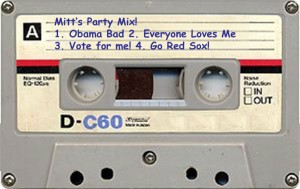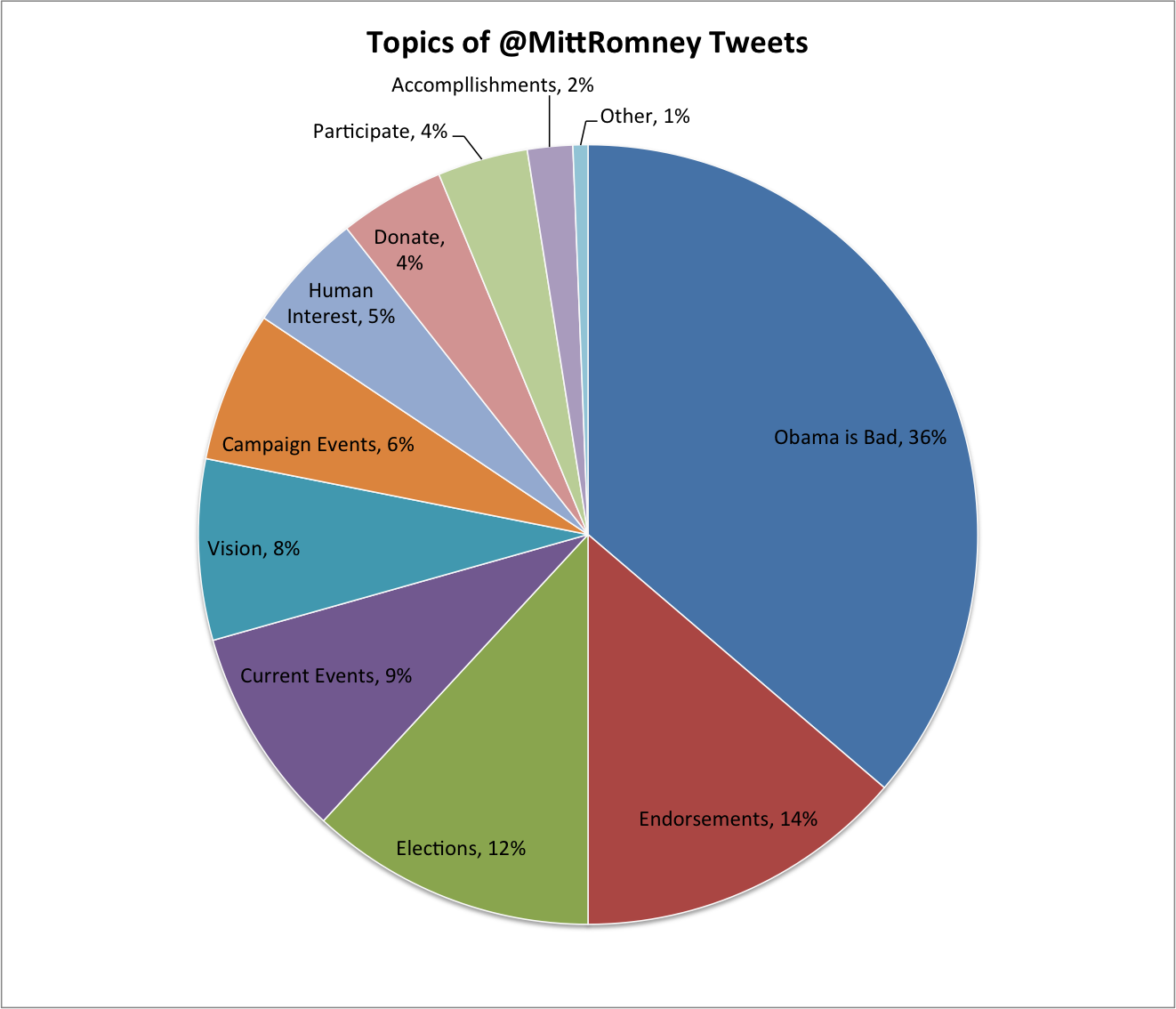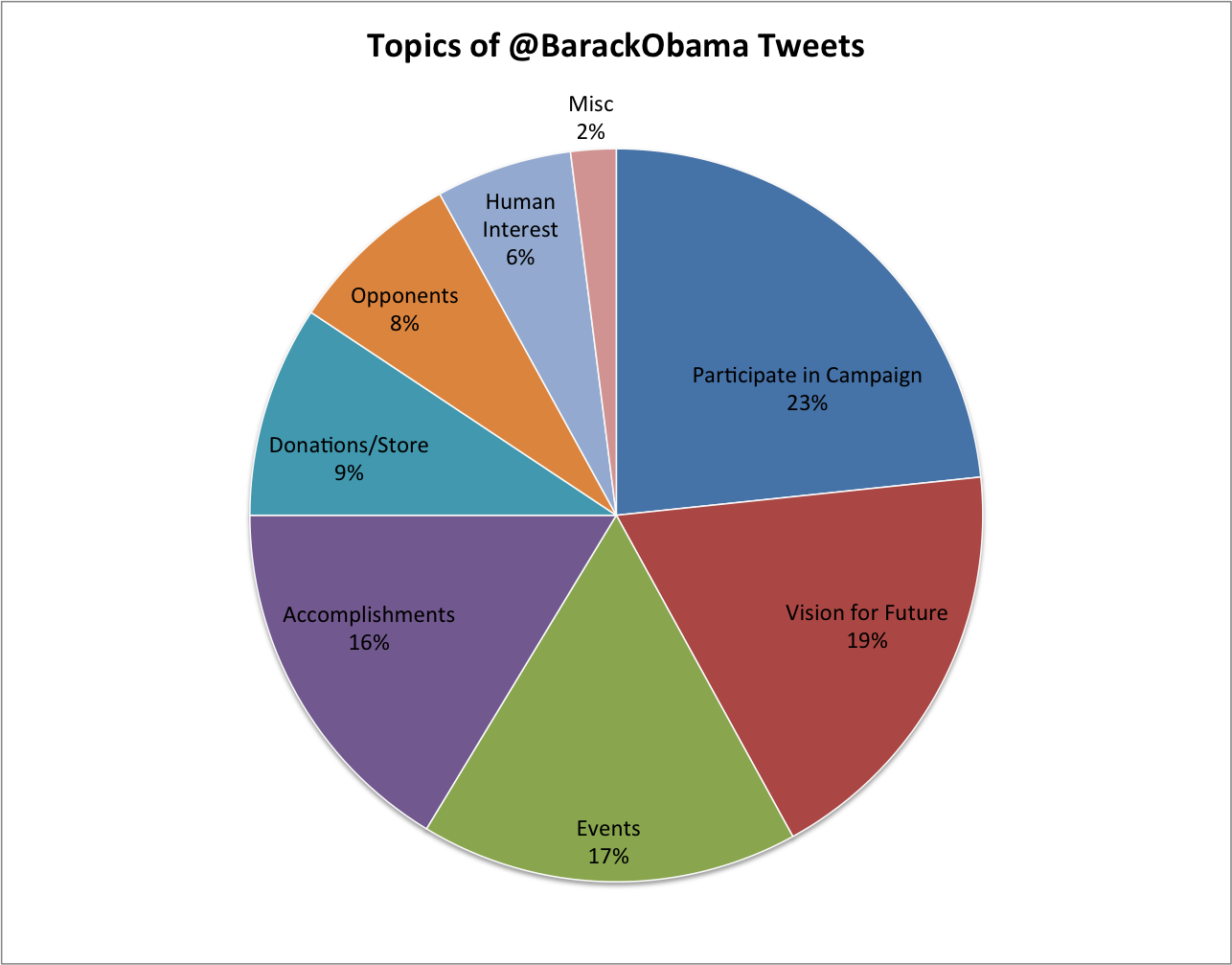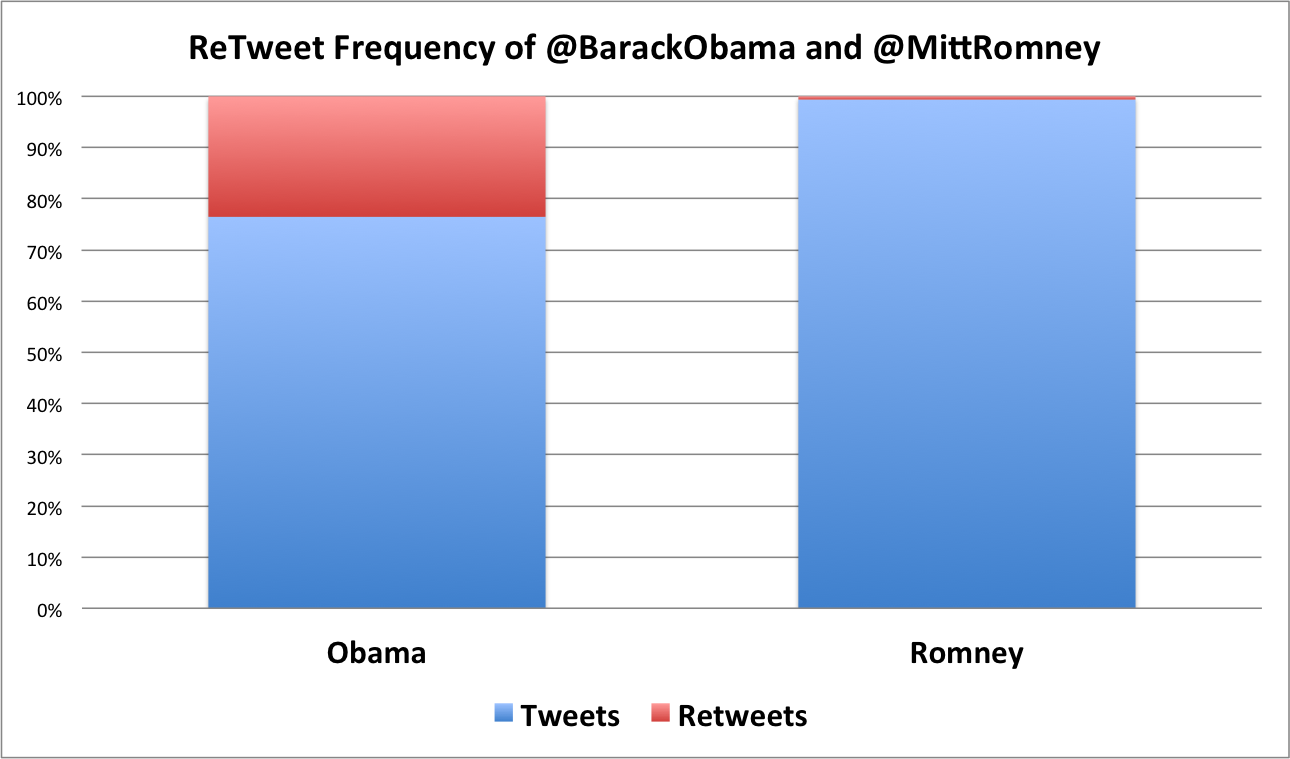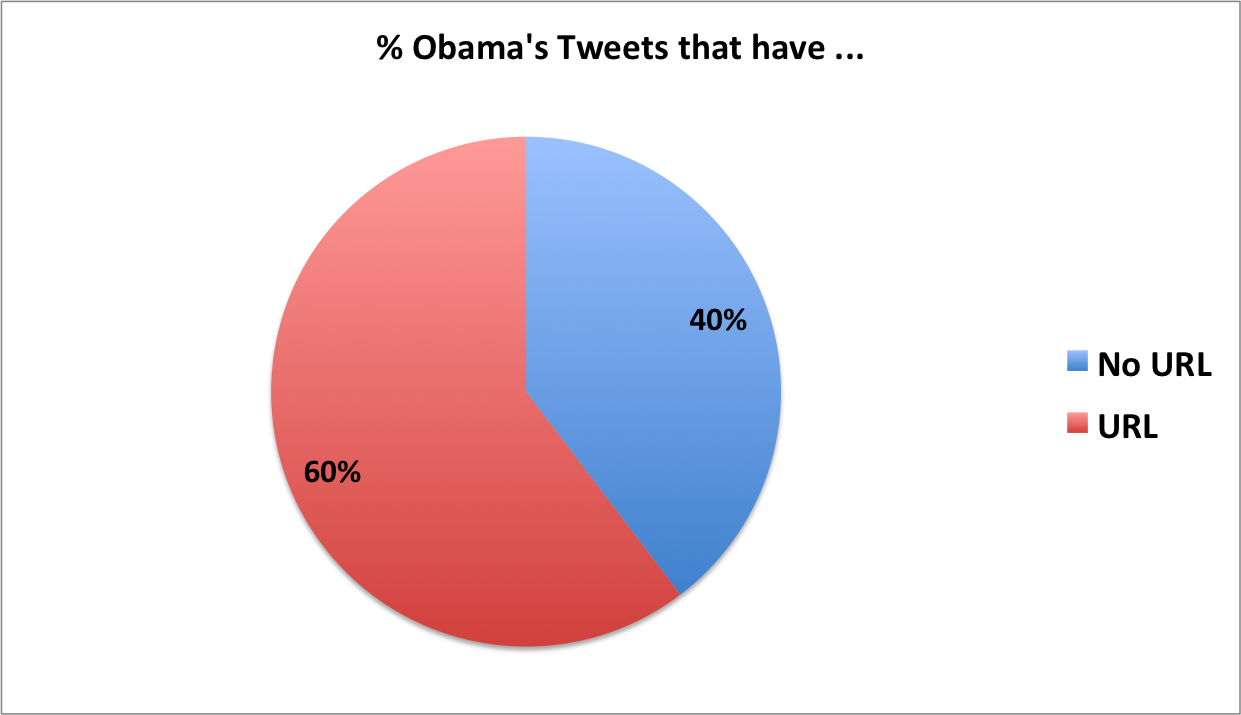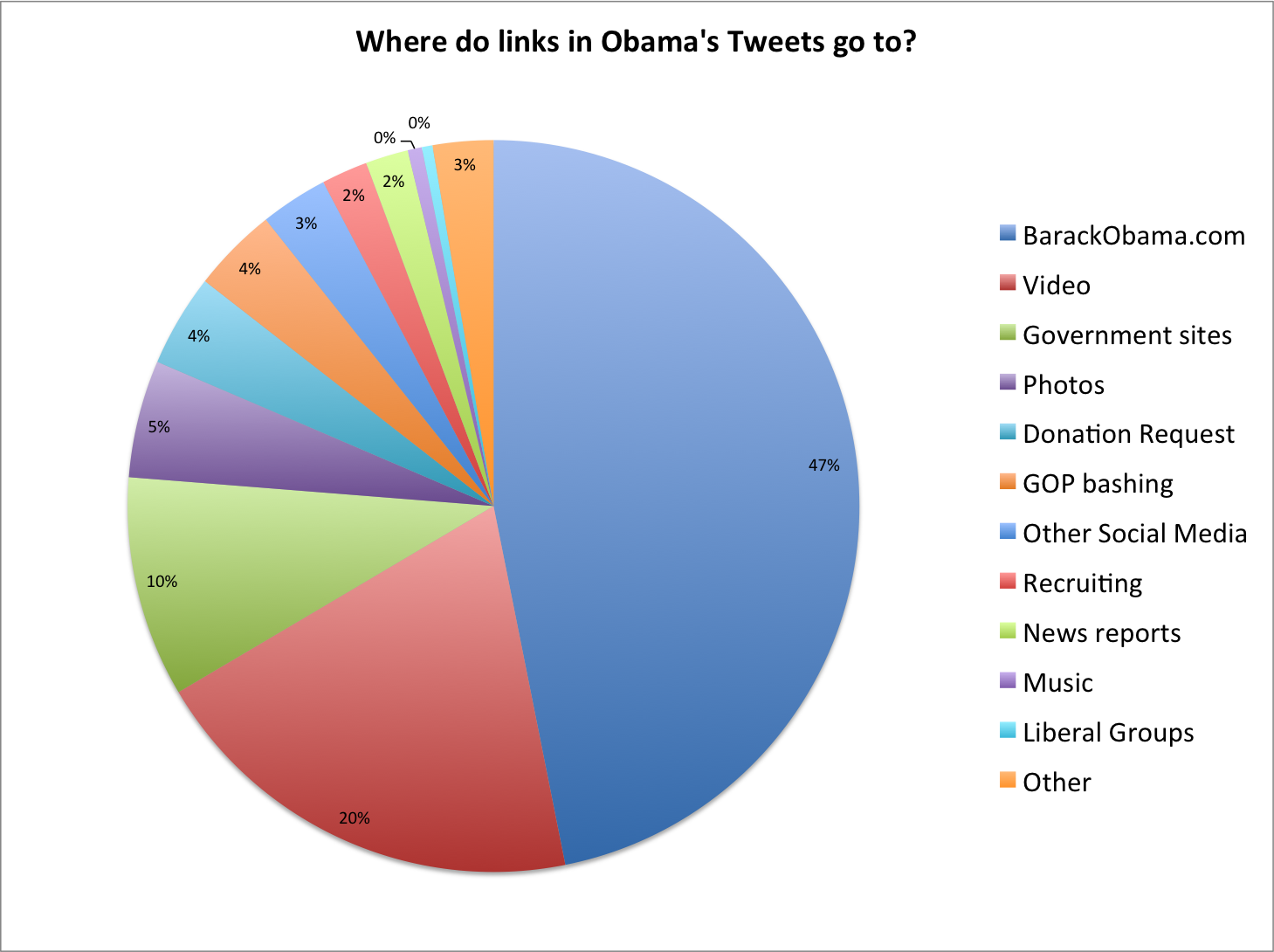[For the background on this series, please see the Introduction first]
Imagine you’re a candidate, and you want to reach voters, volunteers, and donors with Twitter. What do you say?
I recently posted a semi-humorous infographic, Every Political Tweet Ever Sent, which gives a a laundry list of topics. You could just throw a dart at it and tweet whatever that lands on. But if you look at top-tier political campaigns, you’ll see that they really focus on topics that match their situation and focus on their perceived strengths.
Let’s start with Mitt Romney, to give a bit of variety, before we look at Obama. @MittRomney’s tweets are focused in the following areas:
This is a categorization of his tweets from February 1st on. And, we can see, as he was working through the last primaries (that counted), he was focused on two things: Trying to define who President Obama is and why he should not be elected, and winning the last of the primaries by discussing the endorsements he was picking up and the specific primary elections he was involved in.
There are two observations about Mitt I think are worth making:
The first is he was not looking to draw people to his campaign either as volunteers or as donors. He was looking to drive the remaining primary opponents out of the race and claim the mantle of presumptive GOP nominee.
The second is that he wasn’t giving people a great reason to vote for him when he just defines himself as opposition to the President. Personally, I think that’s not a strategy he can keep up all the way to the general election unless the economy tanks. John Kerry tried to be the “not-Bush” candidate and it fell apart on him. So I expect that, over time, he will have to spend more time talking about his accomplishments and vision.
If I’m right, perhaps his Twitter patterns will start to look more like Obama’s:
Although I have broken “Accomplishments” and “Vision for Future” apart, I tend to think of them as being flip sides of the same coin — making the positive case for why people should support the President. And the two combined represent roughly a third of the @BarackObama tweets. He is clearly focused on telling people why they should re-elect him.
The next largest category is asking people to participate in the campaign in some fashion, from the very simple step of signing up on his website to hiring on to the campaign as a full time staffer. This is probably a reflection of the early stage of the campaign as he’s looking to build out his state and community level organizations.
Like with Romney, I expect Obama’s patterns to change over time. We’re already seeing some of that, as the campaign is spending increasing amounts of time focusing on Romney’s record at Bain Capital and as governor of Massachusetts.
Regardless, the lesson here is to have a mixture of tweet types to keep your Twitter stream interesting. One great way to do that is to occasionally re-tweet others whose messages are compatible with yours. That takes some work, though, in identifying the appropriate tweets for re-tweeting. We can see here a divergence between the two presidential campaigns:
Mitt Romney almost never, ever retweets anyone. But, in general, Mitt is far less active on Twitter. Up until this point it’s been clear that there’s not been the kind same focus on Twitter that the Obama team has except when there’s the occasional hot topic.
On the other hand, about 25% of Obama’s tweets are retweets. About half of those are coming from his other campaign Twitter accounts. Taking those out of the equation, the best practice seems to be a goal of 10%-15% of unrelated retweets. They make great filler, too, if you have nothing original to say to keep a constant level of tweeting up. But if you retweet much more than 15% of the time, you are starting to drift off message.
Another interesting topic is how often to put links into your tweets. It’s tempting to put a link to your website in every tweet, but remember that if users click on your account in Twitter they’ll see your website’s URL in your profile. So just reflexively having a link in your tweet just takes up very limited space. Conversely, tweets that relate to specific topics that have a their own landing page on your web site are great for links. If you have a tweet on national defense and you have a page that explains more about your position, put that link in.
But it’s also OK to send out tweets that just convey a message without a link. The Obama campaign sends out more tweets with links than without, but not overwhelmingly so:
That’s a nice mix.
The next question is, when you put links into a tweet, where do the links go to? Just as you don’t want every tweet to have a link to your home page, you don’t want every link to go to your web site. When Obama includes links, here’s what he links to:
Interesting that only about half of his links to to his web site, isn’t it? The others go to a rich mixture of content including multi-media, official web sites, and others. As you can see, between the content of his tweets and the destination of their links, @BarackObama has a very diverse set of tweets. As a counter-example, Mitt Romney sends about 3/4ths of his links back to his website, which is more a demonstration of a lower level of effort than anything else.
(Note that Obama nonetheless tracks clicks on all the links — see Secret #1 for details on that)
Summing it all up …
- First and foremost, remember: Any individual tweet you send may be the only tweet of yours a person sees. Make every one be interesting enough to have some sort of impact.
- Still, have a variety of topics in your tweets, aligned with the messages you are promoting at this time. The tweets should be driven by your overall positioning as well as current events, promotions, and activities.
- Mix it up between focusing on selling the candidate, asking people to become involved, and general human interest topics (that make the candidate relatable)
- Use links a bit over half of the time.
- Have rich media to share — photos, videos (which you should be doing on YouTube because of its incredible reach), not just static web pages
Keep up to date with future updates to this series by following me on Twitter and/or subscribing to updates to this website. To see all posts in this series, visit the overview page.

